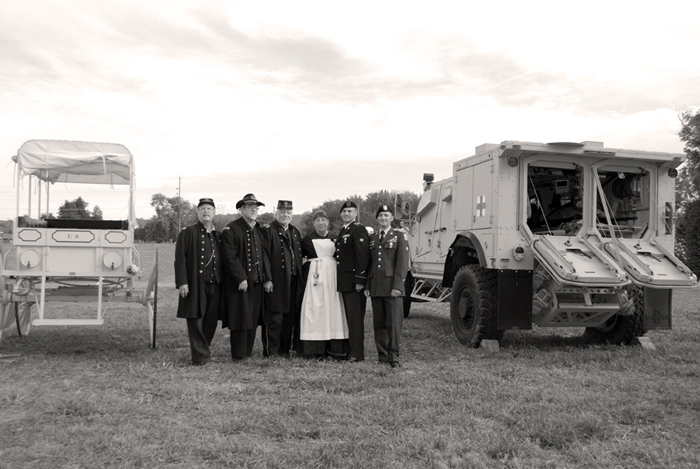Army medicine: 150 years later

The chilly September morning gave light as the sun rose over the battlefield where the bloodiest single day in American military history took place 150 years ago. Nearly 23,000 people were killed, wounded or missing during the Battle of Antietam (Md.) on Sept. 17, 1862. The Pry House was used as Union Headquarters during the battle, and the barn beside it was stationed as a field hospital. For the anniversary commemoration, the grounds of the Pry House Field Hospital Museum were transported back a century and a half as living historians from across the United States re-created the Pry House grounds during the Civil War. Among the century-and-a-half-old re-creation, sat a very modern, Mine-Resistant Ambush-Protected ambulance prototype.
The U.S. Army Medical Materiel Development Activity, Fort Detrick, Md., was invited to participate in the event and display a comparison of Civil War Army Medicine with that of present day. The USAMMDA brought one of the vehicle prototypes which sat beside the Civil War Wheeling Ambulance. The contrast between the two vehicles was obvious; however, there were some striking similarities between the two ambulances. The Wheeling Ambulance was a simple wooden wagon with four wooden wheels that could fit six ambulatory or two littered patients; it was drawn by horses and carried jugs of water on the back. The MRAP ambulance of today's Army Medicine is made of heavy duty steel, has re-inflating heavy duty rubber wheels, and carries four ambulatory or two littered patients. It is drawn by a 370-horsepower diesel engine and carries jugs of water on the back, as well as modern life-saving equipment for treatment of serious injuries on the battlefield.
Thomas Frezza, superintendent of the Pry House Field Hospital Museum, National Museum of Civil War Medicine, described the comparison display as one of the major attractions of the weekend.
"It seems that the display was one of the most visited sites during the weekend," said Frezza. "I asked visitors what they thought, and a majority said that they were happy to see the two time periods represented, and that they are glad to know what is being done to protect and treat our wounded on the battlefield today."
To aid in the presentation of the comparison, the MRAP was accompanied by two active duty Army Medics, Spc. Daniel Vita and Spc. William Lipscomb, 68W Health Care Specialists, at the U.S. Army Medical Research Institute of Infectious Diseases, Fort Detrick. The Soldiers gave firsthand experience to visitors with regard to the medical equipment that the Army Medics use today. Vita acknowledged the differences in battlefield medicine, saying that the contrast is overwhelming not only from what the equipment is made of, but how the whole scope of point-of-injury care has changed.
Steve Hawbecker, project manager of Medical Support Systems Project Management Office, USAMMDA, provided subject-matter expertise for the products on display, as well as current projects in development such as vehicles, shelters, and casualty evacuation and treatment equipment.
"The comparison of Army Medicine past and present provided real insight into how the Soldier is now treated at the point of injury and throughout evacuation, not just removed from the battlefield as occurred in the Civil War." said Hawbecker. "Attendees at the event were very appreciative of the medical advances achieved by USAMMDA that exemplified the efforts the Army makes to save our wounded Soldiers."
The USAMMDA display included a wide range of current Army medical portfolio products, including the wheeled litter carrier, special medical emergency evacuation device, trauma tiered medic bag, improved first aid kit, and freeze dried plasma.
As a young Soldier being a part of this event, Vita gained an enormous appreciation for the advances in medical technology.
"I took away from this experience a better understanding of where Army medicine began," said Vita. "What I was taught when I first began as a medic actually started at the Battle of Antietam with an officer named Major Letterman. It gives me a realization that the place I was standing, and what happened there, changed how things are done today."
Frezza estimated roughly six thousand visitors toured the grounds of the Pry House over the weekend ' a number the house has never seen before.
"It was a very successful event," said Frezza. "Visitors came away with a lot of knowledge, be it Civil War or today, and hopefully an experience that they will remember."
While the Army will continue making medical improvements and advances, it is important to not forget where it all started. We have been taught so much today from what occurred 150 years ago, on a battlefield not far from Fort Detrick, where so many men lost their lives.














